Panasonic DMC-L1 Digital SLR Review
Panasonic DMC-L1 Digital SLR
With brands like Panasonic, Leica and Olympus behind it, the DMC-L1 must be great right?
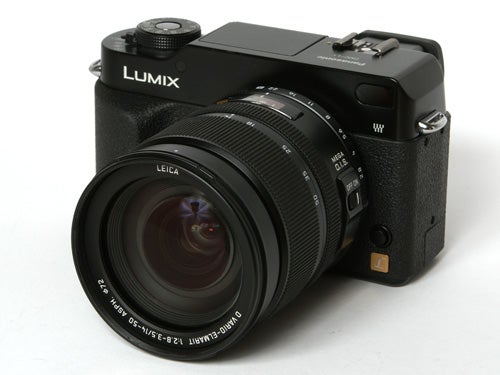
Verdict
Key Specifications
- Review Price: £1147.95
The digital camera industry has seen some highly productive partnerships between big electronics companies and traditional camera brands, particularly in the area of digital SLRs. Sony partnered with Konica-Minolta, which resulted in the Alpha A100, Samsung joined forces with Pentax to launch its re-badged line of GX-series SLRs, and now Panasonic has teamed up with Leica and Olympus to produce the DMC-L1, the company’s first foray into the competitive DSLR market, and the first non-Olympus camera to use the Four Thirds sensor and lens mount format.
The L1 is a 7.5-megapixel digital SLR featuring live monitor view (only the second digital SLR to do so) and supplied with a fast f/2.8–3.5 Leica-branded lens. It currently sells on the high street for a whopping £1,349.99, although it is available from at least one online retailer for around £1,150. This seems expensive at first glance, especially compared to other similarly specified SLRs, but a Canon EOS 400D with a EF-S 17-55mm f2.8 IS USM lens will cost you nearly £1,100. Fast lenses are very expensive.

The lens supplied with the L1 is certainly an impressive-looking item. It is physically very large, 98mm long and 77mm in diameter, and weighs just over 500g, contributing nearly half of the total weight of the kit. Its maximum aperture of f/2.8–3.5 is much faster than the standard kit lenses supplied with rival cameras. It is also fitted with Panasonic’s proprietary optical image stabilisation system, Mega OIS, which has been shown to provide at least two stops of additional stability. The lens is not currently available separately, which will probably disappoint many Olympus owners. Likewise the L1 is not available body-only, so there’s no chance of saving money by getting it with a less expensive Olympus or Sigma 4/3 lens.
Panasonic trades heavily on this almost religious reverence that a lot of photographers have for the Leica name, even though its Leica-branded lenses are in fact made by Panasonic in a factory in Japan. The design of the L1 is clearly intended to resemble a classic 35mm rangefinder camera, and all the publicity pictures of it are carefully shot to emphasise that aspect.
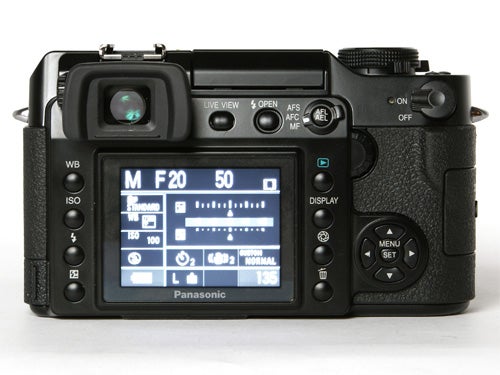
However this is a bit of a fraud, because as soon as you actually handle the camera or even see it from any angle other than front-on you realise that beyond the retro-styled shutter speed dial and aperture ring – and the huge price tag – it bears no relation to a rangefinder camera at all. For a start it’s twice as thick and twice as heavy. The camera body measures 145 x 86.9 x 80mm, and with the lens attached weighs a hefty 1080g. The main advantages that rangefinder cameras have over SLRs are their light weight and slim size, but the L1 has neither so why is it designed to look like a rangefinder?
It’s certainly not for the handling. Throughout the test period I found the L1 to be heavy, ungainly and uncomfortable. Despite its massive thickness the shape is difficult to grip securely, and the camera always felt unbalanced by the enormous weight of the lens.
The relative positions of the right-hand strap lug and the awkwardly positioned shutter button mean that the strap is always getting in the way when you’re trying to take a picture, and position of the on/off switch on the back thumb grip area means that it’s easy to switch it on accidentally. There’s a reason why most modern SLR cameras are roughly the same shape; it’s because a large ergonomic handgrip and a forward-angled shutter button are easier and more comfortable to use. The L1 has neither.
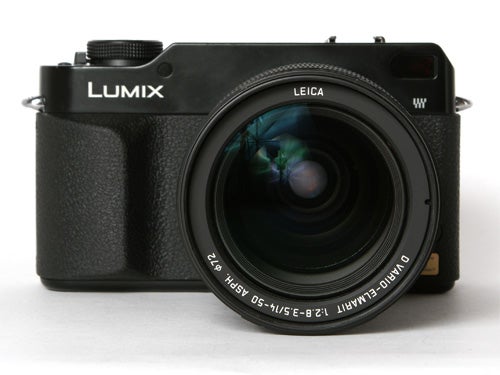
As I mentioned, the L1 has a retro-styled manual dial on the top plate for setting the shutter speed. This is easy enough to use, and will no doubt appeal to older users. However it does have its problems. In order to set the shutter speed to automatic, you have to turn the dial to the ‘A’ position, but you can only do this from one direction. To go from high shutter speeds to automatic you have to go right round the dial. Furthermore, not all of the shutter speed range can be set from the dial. To set speeds from 1/1000th to 1/4000th of a second, or from two seconds to 60 seconds, you have to first turn the dial to the appropriate position and then adjust the setting further using the up and down arrows on the D-pad. This seems pointlessly fiddly compared to the simple command dial setting on most other DSLRs.
At least the aperture ring on the lens is easy enough to use and operates smoothly. Setting the aperture to automatic is simply a matter of turning the ring all the way to the left and then pressing the lock button, something that will be familiar to anyone with an older manual SLR.
The other controls are fairly straightforward, with only the flash opening button having any surprises. The flash pops up in two stages, with the first providing a bounce flash option, which is very useful for softer indoor lighting. The aperture preview button only works in live view mode, but does show the stopped-down image at the correct brightness.
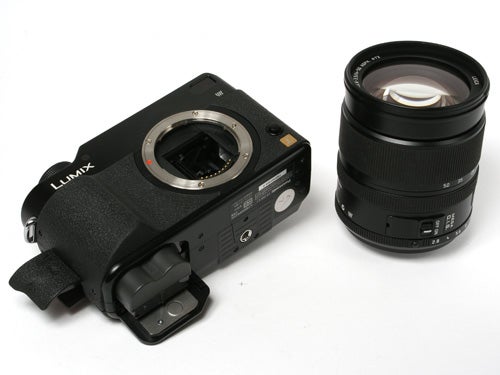
Most adjustments are made via the menu, including four pre-set “film” options, in fact pre-defined sets of contrast, sharpness, saturation and noise reduction, each of which can be adjusted manually through five steps. This is nice and easy to use, and the film mode can be programmed onto one of the two function buttons, so switching between them can be quick and easy.
Although the L1 has none of the user-friendly scene modes found on most other DSLRs, it does offer both digital zoom and the deceptively-named Extra Optical Zoom, in fact just another crop-and-enlarge feature. For some reason these two features are only available in the live view mode.
In use the L1 has its ups and downs. It doesn’t start up as quickly as some DSLRs, but it is ready to go in just over a second, which is fast enough for most people. The AF system is nice and quick in good light, and focuses well although often a bit more slowly in low light. It only has three focus points, clustered close together in the middle of the frame. It is possible to select one of these focus points manually, but this has to be selected in the custom menu. In viewfinder mode shutter lag is minimal.
In high speed continuous shooting in JPEG mode the L1 is exceptionally fast, shooting at over three frames a second, and appears to be able to maintain this rate until the memory card is full. Adding RAW shooting doesn’t slow the shooting speed, but does limit it to a six-shot burst, which then takes fifteen seconds to write to the memory card. Fortunately the buffer is dynamic, so an additional shot can be taken once the first has been written.
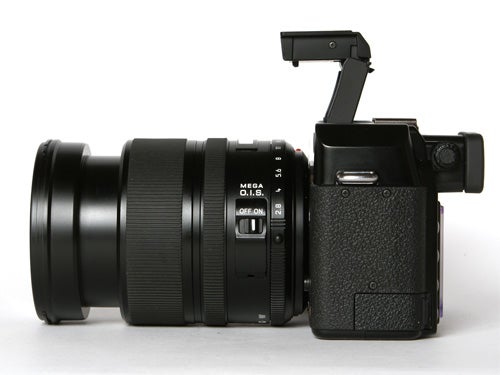
JPEG files at maximum quality average around 4MB, although some were as high as 5.7MB. RAW files are 14.34MB. Shooting JPEG only, a 1GB card is enough for 135 shots, or 44 if shooting RAW too. Battery life seemed to be excellent. The big 1500mAh Li-ion cell was still reading 2/3 full after over 235 shots.
The Panasonic L1 borrows heavily from another recent SLR camera that I’ve reviewed here, the Olympus E-330. Not only does it use the Four Thirds sensor and lens mount, it also uses the E-330’s convoluted optical path to provide the same live monitor view, or rather it uses some of it. The E-330 has two live view modes, one of which uses a second CCD in the optical path to provide a continuous live view.
The L1 has the same optical path but the secondary CCD itself is absent, so it only has one live view mode. This has several disadvantages, not least of which is the very dark viewfinder. It also makes using the live view mode very slow, since because it uses the CCD the reflex mirror has to move for metering, and then again for focusing, and the view is frozen while it does this.
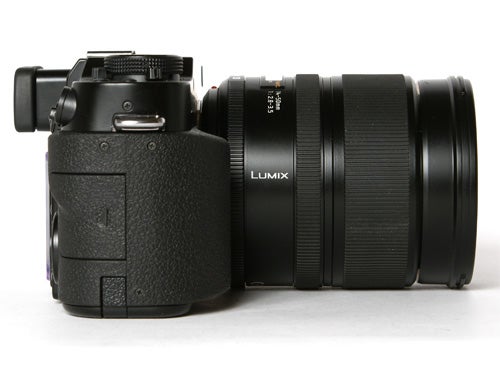
The L1 has a nice sharp 2.5-in LCD monitor with 207k pixels, but whereas the E-330 had a hinged monitor which was useful for overhead or waist-level shooting using the live view mode, the monitor on the L1 is fixed so it doesn’t have this advantage. In fact it’s hard to name any advantage that the L1 has at all.
The build quality of the camera body is very good, with a solid metal chassis and only a few plastic parts. The finish is very good, with a textured rubber coating over most of the camera body and a smooth black lacquered finish over the rest of it. The fit and mounting of most of the controls is also very solid, although I found that the switches for metering mode, drive mode and even the on/off switch were quite loose and easy to jog accidentally.
Unfortunately, and rather surprisingly, the build quality of the Leica lens is not so good. I know there are some people who would burn me as a heretic for saying so, but I was not impressed. The action of the zoom ring is very rough, with a definite ‘clunk’ half way through its travel, and it actually stuck briefly while I was using it. The lens barrel itself is plastic, and feels quite cheap and flimsy in places.
It seems odd to me that Panasonic would go to the trouble of having a retro-style aperture control ring, but then design the lens with a slow and unresponsive electro-mechanical manual focus ring. Also, I’m pretty sure that the front elements of real Leica lenses aren’t supposed to wobble. This one does, which really can’t help with the optical quality.
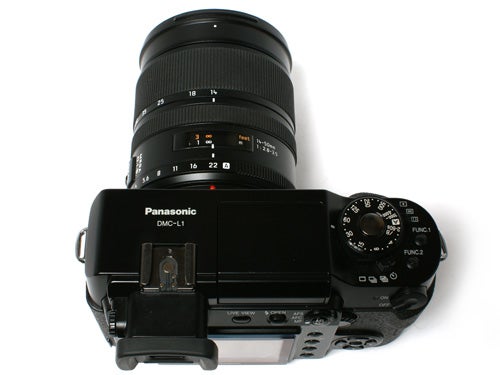
It’s the quality of that lens that is the main selling point of the camera, and while it is good, it’s not as good as I’d hoped. I found corner softness, slight chromatic aberration and noticeable barrel distortion, none to an alarming degree but certainly more than I’d expect from such an expensive lens. I took the same sample shots with it as I have taken with several other mid-range DSLRs, including the £400, 6-megapixel Pentax K100D, and to be honest I thought the Pentax produced better pictures.
Panasonic cameras have always had a reputation for image noise problems, and unfortunately the L1 is no exception. There was visible noise from 400 ISO upwards, and shots at the 1600 ISO maximum were effectively unusable. There were also visible purple fringes on a number of high-contrast shots, again not something I’d expect to see on a camera claiming professional credentials. While the AF system performed well, I did encounter some problems with the exposure metering. It seemed easily confused by high contrast or backlit subjects, and required frequent use of exposure compensation to correct it.
”’Verdict”’
Although the Panasonic DMC-L1 is an interesting first SLR and the retro styling will no doubt appeal to some, and while its performance and build quality are excellent, the uncomfortable handling, dark viewfinder and fiddly controls are a handicap. It suffers from the usual Panasonic image noise problems, and the optical quality of the Leica-branded lens isn’t all its cracked up to be. There are better DSLRs with better lenses for a lot less money.
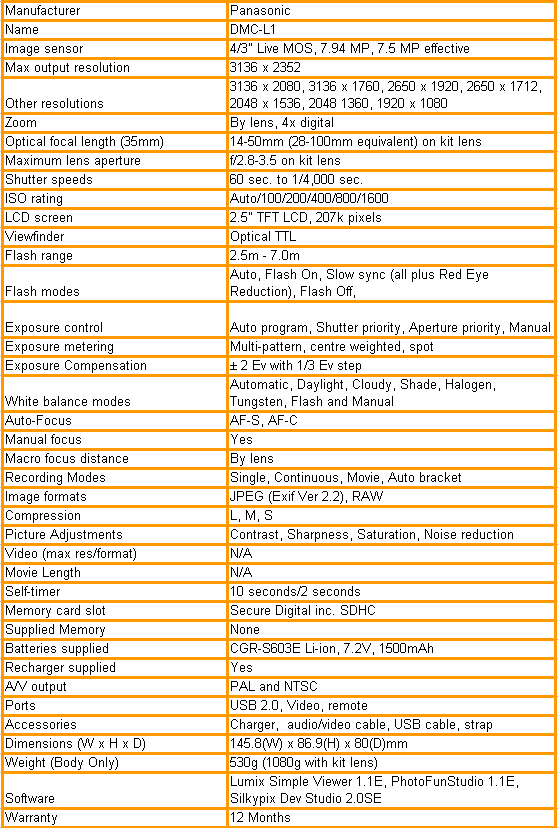
A range of test shots are shown over the next few pages. Here, the full size image has been reduced for bandwidth purposes, and a crop taken from the original full resolution image has been placed below it in order for you to gain an appreciation of the overall quality.
—-


1/50th, f/4, ISO 100
At the minimum ISO setting the picture is silky smooth with no noise, as you’d expect.
—-

1/60th, f/5, ISO 200
At 200 ISO there is still no image noise.
—-

1/125th, f/5.6, ISO 400
Up to 400 ISO and already there is visible noise in the darker areas of the image.
—-

1/160th, f/6.3, ISO 800
At 800 ISO the image noise is now quite significant, but the image is just about usable.
—-

1/200th, f/8, ISO 1600
At the maximum 1600 ISO the image noise is now so bad that the shot is effectively unusable.
—-
A range of test shots are shown over the next few pages. Here, the full size image has been reduced for bandwidth purposes, and a crop taken from the original full resolution image has been placed below it in order for you to gain an appreciation of the overall quality. The following pages consist of resized images so that you can evaluate the overall exposure. For those with a dial-up connection, please be patient while the pages download.
—-

This is a shot I’ve used in many camera reviews for evaluating detail. If you can see the anti-bird netting it’s doing well.
—-

A 100 percent crop of the above image, showing the level of fine detail in the centre of the frame. Compare this with the similar shot in the review of the sub-£400 6MP Pentax K100D.
—-
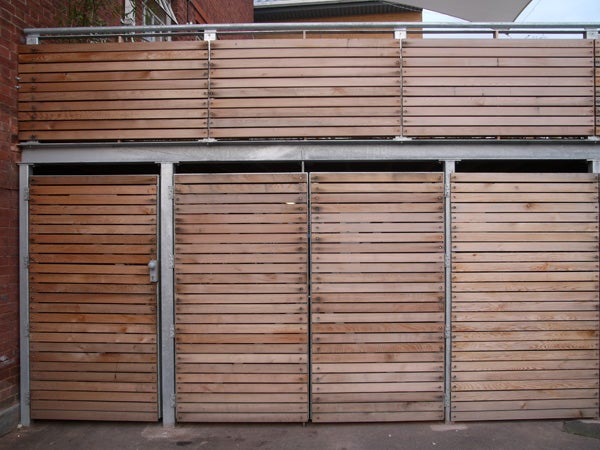
Considering the price of the kit and the bulletproof reputation of Leica optics, I wasn’t expecting to see significant barrel distortion at the widest angle setting.
—-
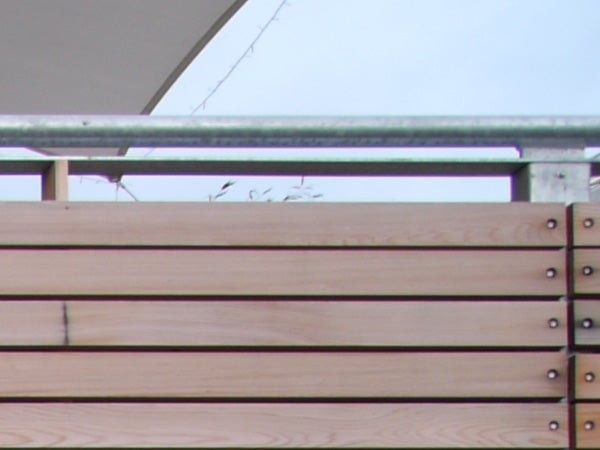
I also wasn’t expecting to see (admittedly slight) corner softness and purple fringes.
—-
This page consists of resized images so that you can evaluate the overall exposure.
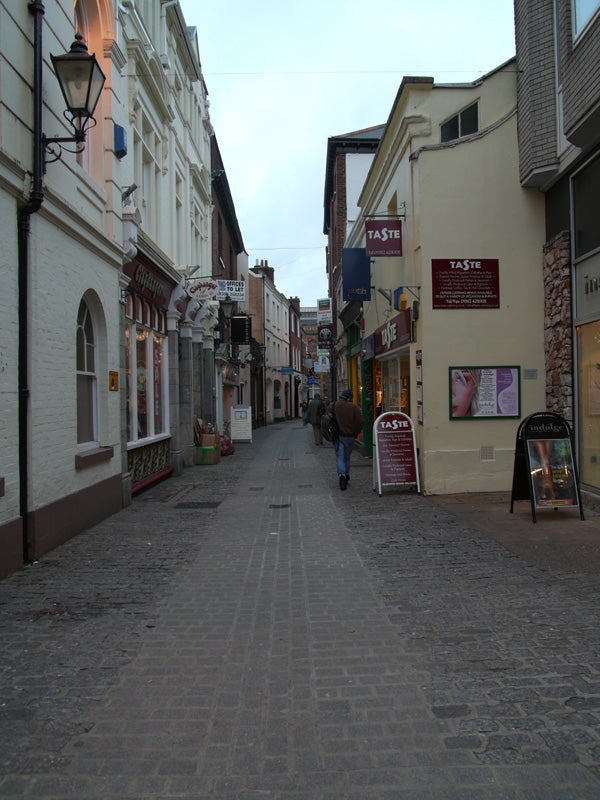
In the 4/3 system, the 14mm wide angle end of the zoom range is equivalent to 28mm on a film camera, a ratio of 1:2…
—-

…which makes the 50mm telephoto end equivalent to 100mm.
—-
This page consists of resized images so that you can evaluate the overall exposure.
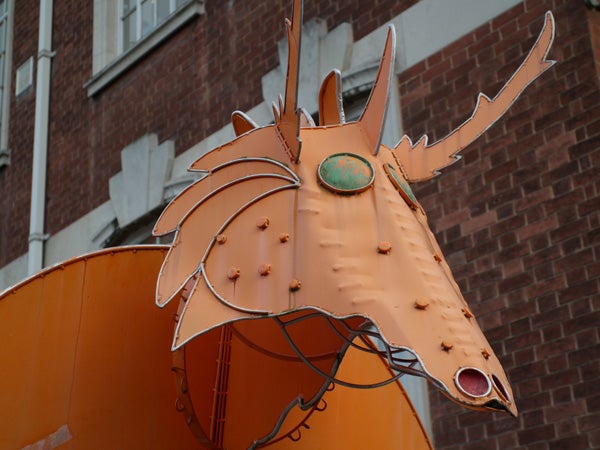
The f/3.4 maximum aperture at the long end of the zoom range gives outstanding control over depth of field. The colour rendition is also excellent.
—-

The metering system seriously under-exposed this shot, and 2 stops of exposure correction was required to correct it.
—-
Trusted Score
Score in detail
-
Value 2
-
Image Quality 8
Features
| Camera type | Digital SLR |
| Megapixels (Megapixel) | 7.5 Megapixel |
| Optical Zoom (Times) | 1.5x |
| Image Sensor | Live MOS |
| Image Stabilisation | Optical |
| LCD Monitor | 2.5 in |
| Flash modes | Auto Flash, Flash OFF, Flash ON, Red-eye Reduction |
| Memory card slot | Secure Digital (SD) Card, Secure Digital High Capacity (SDHC) Card, MultiMediaCard (MMC) |

